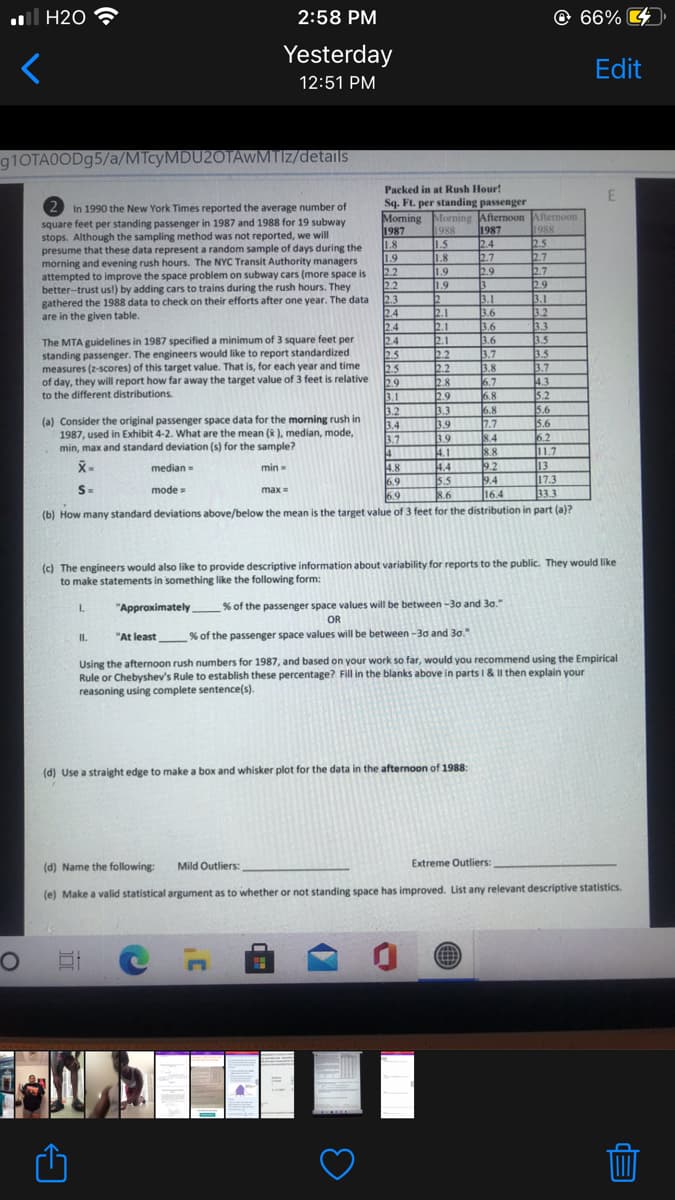Packed in at Rush Hour! Sq. Ft. per standing passenger In 1990 the New York Times reported the average number of square feet per standing passenger in 1987 and 1988 for 19 subway stops. Although the sampling method was not reported, we will presume that these data represent a random sample of days during the morning and evening rush hours. The NYC Transit Authority managers attempted to improve the space problem on subway cars (more space is better-trust usl) by adding cars to trains during the rush hours. They Moming Morning Afternoon Afternoon 1988 25 2.7 2.7 2.9 3.1 3.2 3.3 3.5 3.5 3.7 4.3 5.2 5.6 5.6 62 11.7 13 17.3 333 1987 1.8 1.9 22 22 23 1988 1.5 1.8 1.9 1.9 1987 24 2.7 29 gathered the 1988 data to check on their efforts after one year. The data 2.4 24 2.4 25 2.5 of day, they will report how far away the target value of 3 feet is relative 3.1 3.6 3.6 3.6 3.7 3.8 5.7 6.8 5.8 7.7 84 88 are in the given table. 2.1 2.1 22 22 2.8 2.9 3.3 3.9 3.9 The MTA guidelines in 1987 specified a minimum of 3 square feet per standing passenger. The engineers would like to report standardized measures (2-scores) of this target value. That is, for each year and time 29 3.1 3.2 3.4 3.7|| to the different distributions. (a) Consider the original passenger space data for the morning rush in 1987, used in Exhibit 4-2. What are the mean (k), median, mode, min, max and standard deviation (s) for the sample? min 4.8 44 6.9 55 median - S- mode 9.4 16.4 max 69 8.6 (b) How many standard deviations above/below the mean is the target value of 3 feet for the distribution in part (a)? (c) The engineers would also like to provide descriptive information about variability for reports to the public. They would like to make statements in something like the following form: "Approximately _% of the passenger space values will be between -3o and 30." OR L. I. "At least % of the passenger space values will be between -30 and 30. Using the afternoon rush numbers for 1987, and based on your work so far, would you recommend using the Empirical Rule or Chebyshev's Rule to establish these percentage? Fill in the blanks above in parts i& I then explain your reasoning using complete sentence(s). (d) Use a straight edge to make a box and whisker plot for the data in the afternoon of 1988: (d) Name the following Mild Outliers: Extreme Outliers:
Addition Rule of Probability
It simply refers to the likelihood of an event taking place whenever the occurrence of an event is uncertain. The probability of a single event can be calculated by dividing the number of successful trials of that event by the total number of trials.
Expected Value
When a large number of trials are performed for any random variable ‘X’, the predicted result is most likely the mean of all the outcomes for the random variable and it is known as expected value also known as expectation. The expected value, also known as the expectation, is denoted by: E(X).
Probability Distributions
Understanding probability is necessary to know the probability distributions. In statistics, probability is how the uncertainty of an event is measured. This event can be anything. The most common examples include tossing a coin, rolling a die, or choosing a card. Each of these events has multiple possibilities. Every such possibility is measured with the help of probability. To be more precise, the probability is used for calculating the occurrence of events that may or may not happen. Probability does not give sure results. Unless the probability of any event is 1, the different outcomes may or may not happen in real life, regardless of how less or how more their probability is.
Basic Probability
The simple definition of probability it is a chance of the occurrence of an event. It is defined in numerical form and the probability value is between 0 to 1. The probability value 0 indicates that there is no chance of that event occurring and the probability value 1 indicates that the event will occur. Sum of the probability value must be 1. The probability value is never a negative number. If it happens, then recheck the calculation.

Trending now
This is a popular solution!
Step by step
Solved in 3 steps with 1 images






